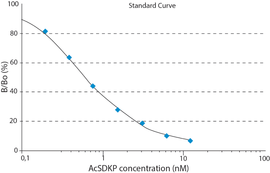Cayman
Showing 8401–8550 of 45550 results
-
Aclidinium (bromide) is a long-acting reversible antagonist at the muscarinic acetylcholine receptors (mAChRs), M1, M2, M3, M4, and M5 (Kis= 0.1, 0.14, 0.14, 0.21, and 0.16 nM, respectively).{34049} It has a fast onset of action and dissociates more slowly from M3 receptors, which are located on bronchial smooth muscle and submucosal glands, than from M2 receptors (t1/2 = 29 and 4.7 hours, respectively) in guinea pigs. It had an improved cardiovascular safety profile compared with tiotropium (Item No. 15773) in Beagle dogs. Inhalant formulations containing aclidinium (bromide) are used in maintenance therapy to reduce bronchospasm in patients with chronic obstructive pulmonary disease.
Brand:CaymanSKU:20699 -Available on backorder
Aclidinium (bromide) is a long-acting reversible antagonist at the muscarinic acetylcholine receptors (mAChRs), M1, M2, M3, M4, and M5 (Kis= 0.1, 0.14, 0.14, 0.21, and 0.16 nM, respectively).{34049} It has a fast onset of action and dissociates more slowly from M3 receptors, which are located on bronchial smooth muscle and submucosal glands, than from M2 receptors (t1/2 = 29 and 4.7 hours, respectively) in guinea pigs. It had an improved cardiovascular safety profile compared with tiotropium (Item No. 15773) in Beagle dogs. Inhalant formulations containing aclidinium (bromide) are used in maintenance therapy to reduce bronchospasm in patients with chronic obstructive pulmonary disease.
Brand:CaymanSKU:20699 -Available on backorder
Acolbifene is a selective estrogen receptor modulator (SERM). It inhibits transcriptional activity of estrogen receptor α (ERα) and ERβ induced by estradiol (E2; Item No. 10006315; IC50s = 2 and 0.4 nM, respectively).{38866} It binds to ERs in cytosol from human breast cancer and non-cancerous uterine cells (Kis = 0.047 and 0.042 nM, respectively) and to ERs in cytosol from rat uterine cells (IC50 = 0.44 nM) but not to progesterone or androgen receptors in cytosol from rat uterine and ventral prostate cells (IC50s = 22,500 and >10,000 nM, respectively).{38866,38867} Acolbifene inhibits E2-stimulated proliferation of T47D, ZR-75-1, and MCF-7 breast cancer cells (IC50s = 0.146, 0.75, and 0.321 nM, respectively) but not basal proliferation.{38866} Acolbifene (50 μg per day) inhibits tumor growth stimulated by estrone (E1; Item No. 10006485) in a ZR-75-1 human breast cancer xenograft model in ovariectomized mice.{38868} It also inhibits E1-stimulated endometrial epithelium thickening in vivo in ovariectomized mice when administered at a dose of 50 μg per day.
Brand:CaymanSKU:23931 - 1 mgAvailable on backorder
Acolbifene is a selective estrogen receptor modulator (SERM). It inhibits transcriptional activity of estrogen receptor α (ERα) and ERβ induced by estradiol (E2; Item No. 10006315; IC50s = 2 and 0.4 nM, respectively).{38866} It binds to ERs in cytosol from human breast cancer and non-cancerous uterine cells (Kis = 0.047 and 0.042 nM, respectively) and to ERs in cytosol from rat uterine cells (IC50 = 0.44 nM) but not to progesterone or androgen receptors in cytosol from rat uterine and ventral prostate cells (IC50s = 22,500 and >10,000 nM, respectively).{38866,38867} Acolbifene inhibits E2-stimulated proliferation of T47D, ZR-75-1, and MCF-7 breast cancer cells (IC50s = 0.146, 0.75, and 0.321 nM, respectively) but not basal proliferation.{38866} Acolbifene (50 μg per day) inhibits tumor growth stimulated by estrone (E1; Item No. 10006485) in a ZR-75-1 human breast cancer xenograft model in ovariectomized mice.{38868} It also inhibits E1-stimulated endometrial epithelium thickening in vivo in ovariectomized mice when administered at a dose of 50 μg per day.
Brand:CaymanSKU:23931 - 10 mgAvailable on backorder
Acolbifene is a selective estrogen receptor modulator (SERM). It inhibits transcriptional activity of estrogen receptor α (ERα) and ERβ induced by estradiol (E2; Item No. 10006315; IC50s = 2 and 0.4 nM, respectively).{38866} It binds to ERs in cytosol from human breast cancer and non-cancerous uterine cells (Kis = 0.047 and 0.042 nM, respectively) and to ERs in cytosol from rat uterine cells (IC50 = 0.44 nM) but not to progesterone or androgen receptors in cytosol from rat uterine and ventral prostate cells (IC50s = 22,500 and >10,000 nM, respectively).{38866,38867} Acolbifene inhibits E2-stimulated proliferation of T47D, ZR-75-1, and MCF-7 breast cancer cells (IC50s = 0.146, 0.75, and 0.321 nM, respectively) but not basal proliferation.{38866} Acolbifene (50 μg per day) inhibits tumor growth stimulated by estrone (E1; Item No. 10006485) in a ZR-75-1 human breast cancer xenograft model in ovariectomized mice.{38868} It also inhibits E1-stimulated endometrial epithelium thickening in vivo in ovariectomized mice when administered at a dose of 50 μg per day.
Brand:CaymanSKU:23931 - 5 mgAvailable on backorder
Aconine is an alkaloid originally isolated from Aconitum species and active metabolite of aconitine.{42252} It inhibits osteoclast differentiation of RANKL-stimulated RAW 264.7 cells and bone resorption in a pit formation assay in a concentration-dependent manner.{42253} Aconine also inhibits RANKL-induced activation of NF-κB and NFATc1 in RAW 264.7 cells. In vivo, aconine is toxic to mice when administered intravenously at a dose of 120 mg/kg.{42252} It induces flaccid paralysis and toxicity in rats with toxic dose (TD50) and LD50 values of 1.5 and 1.7 μmol per animal, respectively.{42254}
Brand:CaymanSKU:25048 - 1 mgAvailable on backorder
Aconine is an alkaloid originally isolated from Aconitum species and active metabolite of aconitine.{42252} It inhibits osteoclast differentiation of RANKL-stimulated RAW 264.7 cells and bone resorption in a pit formation assay in a concentration-dependent manner.{42253} Aconine also inhibits RANKL-induced activation of NF-κB and NFATc1 in RAW 264.7 cells. In vivo, aconine is toxic to mice when administered intravenously at a dose of 120 mg/kg.{42252} It induces flaccid paralysis and toxicity in rats with toxic dose (TD50) and LD50 values of 1.5 and 1.7 μmol per animal, respectively.{42254}
Brand:CaymanSKU:25048 - 10 mgAvailable on backorder
Aconine is an alkaloid originally isolated from Aconitum species and active metabolite of aconitine.{42252} It inhibits osteoclast differentiation of RANKL-stimulated RAW 264.7 cells and bone resorption in a pit formation assay in a concentration-dependent manner.{42253} Aconine also inhibits RANKL-induced activation of NF-κB and NFATc1 in RAW 264.7 cells. In vivo, aconine is toxic to mice when administered intravenously at a dose of 120 mg/kg.{42252} It induces flaccid paralysis and toxicity in rats with toxic dose (TD50) and LD50 values of 1.5 and 1.7 μmol per animal, respectively.{42254}
Brand:CaymanSKU:25048 - 5 mgAvailable on backorder
Brand:CaymanSKU:705503 - 1 eaAvailable on backorder
Aconitase is an iron-sulfur protein containing a [Fe4S4]2+ cluster that catalyzes the stereospecific isomerization of citrate to isocitrate via cis-aconitate. Whereas exposure of aconitase to oxidants renders the enzyme inactive, loss of aconitase activity in cells or in biological samples treated with pro-oxidants has been interpreted as a measure of oxidative damage. Cayman’s Aconitase Assay Kit provides a simple, reproducible, and sensitive tool for assaying aconitase from tissue homogenates or cell lysates. In this assay, citrate is isomerized by aconitase into isocitrate, which is then converted to α-ketoglutarate in a reaction catalyzed by isocitric dehydrogenase. These reactions are monitored by measuring the increase in absorbance at 340 nm associated with the formation of NADPH. The rate of NADPH production is proportional to aconitase activity.
Brand:CaymanSKU:705502 - 96 wellsAvailable on backorder
ACPT-I is an agonist of the group III metabotropic glutamate receptors (mGluRs) mGluR4a and mGluR8 (EC50s = 7.2 and 8.2 µM, respectively) that has no effect on mGluR1a or mGluR2.{5944} It has diverse biological activity, including neuroprotective, anticonvulsant, and anxiolytic-like effects.{38572,38571,38570,38573} ACPT-I (1-200 µM) reduces cell death following oxygen-glucose deprivation in primary neuronal cultures and in a rat model of middle cerebral artery occlusion when used at a dose of 30 mg/kg.{38572} It is neuroprotective against excitotoxicity induced by kainite in vitro and in vivo and reduces the incidence of clonic seizures in various seizure models in mice and rats (ED50s = 0.08-49.3 nM, i.c.v.).{38571,38570} ACPT-I also has anxiolytic-like effects in mice and rats, however, these effects can be blocked by WAY-100635 (Item No. 14599) and flumazenil (Item No. 14252), indicating the involvement of the serotonin (5-HT) receptor subtype 5-HT1A and GABAA receptor.{38573}
Brand:CaymanSKU:78010 - 1 mgAvailable on backorder
ACPT-I is an agonist of the group III metabotropic glutamate receptors (mGluRs) mGluR4a and mGluR8 (EC50s = 7.2 and 8.2 µM, respectively) that has no effect on mGluR1a or mGluR2.{5944} It has diverse biological activity, including neuroprotective, anticonvulsant, and anxiolytic-like effects.{38572,38571,38570,38573} ACPT-I (1-200 µM) reduces cell death following oxygen-glucose deprivation in primary neuronal cultures and in a rat model of middle cerebral artery occlusion when used at a dose of 30 mg/kg.{38572} It is neuroprotective against excitotoxicity induced by kainite in vitro and in vivo and reduces the incidence of clonic seizures in various seizure models in mice and rats (ED50s = 0.08-49.3 nM, i.c.v.).{38571,38570} ACPT-I also has anxiolytic-like effects in mice and rats, however, these effects can be blocked by WAY-100635 (Item No. 14599) and flumazenil (Item No. 14252), indicating the involvement of the serotonin (5-HT) receptor subtype 5-HT1A and GABAA receptor.{38573}
Brand:CaymanSKU:78010 - 10 mgAvailable on backorder
ACPT-I is an agonist of the group III metabotropic glutamate receptors (mGluRs) mGluR4a and mGluR8 (EC50s = 7.2 and 8.2 µM, respectively) that has no effect on mGluR1a or mGluR2.{5944} It has diverse biological activity, including neuroprotective, anticonvulsant, and anxiolytic-like effects.{38572,38571,38570,38573} ACPT-I (1-200 µM) reduces cell death following oxygen-glucose deprivation in primary neuronal cultures and in a rat model of middle cerebral artery occlusion when used at a dose of 30 mg/kg.{38572} It is neuroprotective against excitotoxicity induced by kainite in vitro and in vivo and reduces the incidence of clonic seizures in various seizure models in mice and rats (ED50s = 0.08-49.3 nM, i.c.v.).{38571,38570} ACPT-I also has anxiolytic-like effects in mice and rats, however, these effects can be blocked by WAY-100635 (Item No. 14599) and flumazenil (Item No. 14252), indicating the involvement of the serotonin (5-HT) receptor subtype 5-HT1A and GABAA receptor.{38573}
Brand:CaymanSKU:78010 - 25 mgAvailable on backorder
ACPT-I is an agonist of the group III metabotropic glutamate receptors (mGluRs) mGluR4a and mGluR8 (EC50s = 7.2 and 8.2 µM, respectively) that has no effect on mGluR1a or mGluR2.{5944} It has diverse biological activity, including neuroprotective, anticonvulsant, and anxiolytic-like effects.{38572,38571,38570,38573} ACPT-I (1-200 µM) reduces cell death following oxygen-glucose deprivation in primary neuronal cultures and in a rat model of middle cerebral artery occlusion when used at a dose of 30 mg/kg.{38572} It is neuroprotective against excitotoxicity induced by kainite in vitro and in vivo and reduces the incidence of clonic seizures in various seizure models in mice and rats (ED50s = 0.08-49.3 nM, i.c.v.).{38571,38570} ACPT-I also has anxiolytic-like effects in mice and rats, however, these effects can be blocked by WAY-100635 (Item No. 14599) and flumazenil (Item No. 14252), indicating the involvement of the serotonin (5-HT) receptor subtype 5-HT1A and GABAA receptor.{38573}
Brand:CaymanSKU:78010 - 5 mgAvailable on backorder
ACPT-II is a general competitive antagonist of metabotropic glutamate (mGlu) receptors. The KB values for mGlu1a, mGlu2, and mGlu4a receptors are 115, 88, and 77 µM, respectively.{5944} It binds to the large extracellular domain called a Venus flytrap module, where agonists bind.{30235} ACPT-II is a stereoisomer of the group III mGlu receptor-selective antagonist, ACPT-I.{5944}
Brand:CaymanSKU:78020 - 1 mgAvailable on backorder
ACPT-II is a general competitive antagonist of metabotropic glutamate (mGlu) receptors. The KB values for mGlu1a, mGlu2, and mGlu4a receptors are 115, 88, and 77 µM, respectively.{5944} It binds to the large extracellular domain called a Venus flytrap module, where agonists bind.{30235} ACPT-II is a stereoisomer of the group III mGlu receptor-selective antagonist, ACPT-I.{5944}
Brand:CaymanSKU:78020 - 10 mgAvailable on backorder
ACPT-II is a general competitive antagonist of metabotropic glutamate (mGlu) receptors. The KB values for mGlu1a, mGlu2, and mGlu4a receptors are 115, 88, and 77 µM, respectively.{5944} It binds to the large extracellular domain called a Venus flytrap module, where agonists bind.{30235} ACPT-II is a stereoisomer of the group III mGlu receptor-selective antagonist, ACPT-I.{5944}
Brand:CaymanSKU:78020 - 5 mgAvailable on backorder
ACPT-II is a general competitive antagonist of metabotropic glutamate (mGlu) receptors. The KB values for mGlu1a, mGlu2, and mGlu4a receptors are 115, 88, and 77 µM, respectively.{5944} It binds to the large extracellular domain called a Venus flytrap module, where agonists bind.{30235} ACPT-II is a stereoisomer of the group III mGlu receptor-selective antagonist, ACPT-I.{5944}
Brand:CaymanSKU:78020 - 50 mgAvailable on backorder
Acremine I is a fungal metabolite originally isolated from Acremonium byssoides.{53576} It inhibits germination of P. viticola sporangia by 23.2 and 32.8% when used at concentrations of 0.5 and 1 mM, respectively.
Brand:CaymanSKU:29771 - 1 mgAvailable on backorder
Acridine orange is a cell-permeable, nucleic acid-selective fluorescent cationic dye useful for cell cycle determination and detection of cellular autophagy.{22781,22782,41255} It exhibits excitation/emission spectra of 502/525, 460/650, and 475/590 nm when bound to dsDNA, bound to ssDNA or RNA, and under acidic conditions, respectively.{22781,22782} The ratio of acridine orange emission at 590 to emission at 525 nm can be used to quantify the increase in the number of acidic vesicular organelles observed during cellular autophagy.
Brand:CaymanSKU:-Acridine orange is a cell-permeable, nucleic acid-selective fluorescent cationic dye useful for cell cycle determination and detection of cellular autophagy.{22781,22782,41255} It exhibits excitation/emission spectra of 502/525, 460/650, and 475/590 nm when bound to dsDNA, bound to ssDNA or RNA, and under acidic conditions, respectively.{22781,22782} The ratio of acridine orange emission at 590 to emission at 525 nm can be used to quantify the increase in the number of acidic vesicular organelles observed during cellular autophagy.
Brand:CaymanSKU:-Acridine orange is a cell-permeable, nucleic acid-selective fluorescent cationic dye useful for cell cycle determination and detection of cellular autophagy.{22781,22782,41255} It exhibits excitation/emission spectra of 502/525, 460/650, and 475/590 nm when bound to dsDNA, bound to ssDNA or RNA, and under acidic conditions, respectively.{22781,22782} The ratio of acridine orange emission at 590 to emission at 525 nm can be used to quantify the increase in the number of acidic vesicular organelles observed during cellular autophagy.
Brand:CaymanSKU:-Acridine orange 10-nonyl is a mitochondrial dye and derivative of acridine orange (Item No. 14338) that incorporates into the cardiolipin-rich inner mitochondrial membrane.{36790} It selectively binds to cardiolipin-containing liposomes over phosphatidylserine- and phosphatidylinositol-containing liposomes in vitro (Kas = 0.002, 7,000, and 7,000 mM, respectively). Acridine orange 10-nonyl binding to mitochondria is abolished by the mitochondrial uncoupler FCCP (Item No. 15218) in rat cortical astrocytes, neonatal cardiomyocytes, and isolated brain mitochondria, indicating dependence on mitochondrial membrane potential.{36791} Acridine orange 10-nonyl displays excitation/emission maxima of 490/510 nm, respectively, and has been used to quantify cardiolipin content and mitochondrial mass in isolated mitochondria and cellular systems.
Brand:CaymanSKU:25545 - 10 mgAvailable on backorder
Acridine orange 10-nonyl is a mitochondrial dye and derivative of acridine orange (Item No. 14338) that incorporates into the cardiolipin-rich inner mitochondrial membrane.{36790} It selectively binds to cardiolipin-containing liposomes over phosphatidylserine- and phosphatidylinositol-containing liposomes in vitro (Kas = 0.002, 7,000, and 7,000 mM, respectively). Acridine orange 10-nonyl binding to mitochondria is abolished by the mitochondrial uncoupler FCCP (Item No. 15218) in rat cortical astrocytes, neonatal cardiomyocytes, and isolated brain mitochondria, indicating dependence on mitochondrial membrane potential.{36791} Acridine orange 10-nonyl displays excitation/emission maxima of 490/510 nm, respectively, and has been used to quantify cardiolipin content and mitochondrial mass in isolated mitochondria and cellular systems.
Brand:CaymanSKU:25545 - 25 mgAvailable on backorder
Acridine orange 10-nonyl is a mitochondrial dye and derivative of acridine orange (Item No. 14338) that incorporates into the cardiolipin-rich inner mitochondrial membrane.{36790} It selectively binds to cardiolipin-containing liposomes over phosphatidylserine- and phosphatidylinositol-containing liposomes in vitro (Kas = 0.002, 7,000, and 7,000 mM, respectively). Acridine orange 10-nonyl binding to mitochondria is abolished by the mitochondrial uncoupler FCCP (Item No. 15218) in rat cortical astrocytes, neonatal cardiomyocytes, and isolated brain mitochondria, indicating dependence on mitochondrial membrane potential.{36791} Acridine orange 10-nonyl displays excitation/emission maxima of 490/510 nm, respectively, and has been used to quantify cardiolipin content and mitochondrial mass in isolated mitochondria and cellular systems.
Brand:CaymanSKU:25545 - 5 mgAvailable on backorder
Acridine orange 10-nonyl is a mitochondrial dye and derivative of acridine orange (Item No. 14338) that incorporates into the cardiolipin-rich inner mitochondrial membrane.{36790} It selectively binds to cardiolipin-containing liposomes over phosphatidylserine- and phosphatidylinositol-containing liposomes in vitro (Kas = 0.002, 7,000, and 7,000 mM, respectively). Acridine orange 10-nonyl binding to mitochondria is abolished by the mitochondrial uncoupler FCCP (Item No. 15218) in rat cortical astrocytes, neonatal cardiomyocytes, and isolated brain mitochondria, indicating dependence on mitochondrial membrane potential.{36791} Acridine orange 10-nonyl displays excitation/emission maxima of 490/510 nm, respectively, and has been used to quantify cardiolipin content and mitochondrial mass in isolated mitochondria and cellular systems.
Brand:CaymanSKU:25545 - 50 mgAvailable on backorder
The acridinium NHS ester can be used to label proteins and nucleic acids. The covalently bound acridinium NHS ester will produce chemiluminescence in the presence of hydrogen peroxide. Acridinium-labeled proteins can be used as a detection method in immunoassays.{2437,2438}
Brand:CaymanSKU:200200 -Available on backorder
The acridinium NHS ester can be used to label proteins and nucleic acids. The covalently bound acridinium NHS ester will produce chemiluminescence in the presence of hydrogen peroxide. Acridinium-labeled proteins can be used as a detection method in immunoassays.{2437,2438}
Brand:CaymanSKU:200200 -Available on backorder
The acridinium NHS ester can be used to label proteins and nucleic acids. The covalently bound acridinium NHS ester will produce chemiluminescence in the presence of hydrogen peroxide. Acridinium-labeled proteins can be used as a detection method in immunoassays.{2437,2438}
Brand:CaymanSKU:200200 -Available on backorder
The acridinium NHS ester can be used to label proteins and nucleic acids. The covalently bound acridinium NHS ester will produce chemiluminescence in the presence of hydrogen peroxide. Acridinium-labeled proteins can be used as a detection method in immunoassays.{2437,2438}
Brand:CaymanSKU:200200 -Available on backorder
Acrivastine is a histamine H1 receptor antagonist with a Ki value of 10 nM in COS-7 cells expressing the human receptor.{39413} In vivo, acrivastine (1 mg/kg) completely inhibits response to histamine in guinea pigs.{39412} Formulations containing acrivastine have been used for the treatment of seasonal allergies and hay fever.
Brand:CaymanSKU:24021 - 10 mgAvailable on backorder
Acrivastine is a histamine H1 receptor antagonist with a Ki value of 10 nM in COS-7 cells expressing the human receptor.{39413} In vivo, acrivastine (1 mg/kg) completely inhibits response to histamine in guinea pigs.{39412} Formulations containing acrivastine have been used for the treatment of seasonal allergies and hay fever.
Brand:CaymanSKU:24021 - 25 mgAvailable on backorder
Acrivastine is a histamine H1 receptor antagonist with a Ki value of 10 nM in COS-7 cells expressing the human receptor.{39413} In vivo, acrivastine (1 mg/kg) completely inhibits response to histamine in guinea pigs.{39412} Formulations containing acrivastine have been used for the treatment of seasonal allergies and hay fever.
Brand:CaymanSKU:24021 - 5 mgAvailable on backorder
Acrivastine is a histamine H1 receptor antagonist with a Ki value of 10 nM in COS-7 cells expressing the human receptor.{39413} In vivo, acrivastine (1 mg/kg) completely inhibits response to histamine in guinea pigs.{39412} Formulations containing acrivastine have been used for the treatment of seasonal allergies and hay fever.
Brand:CaymanSKU:24021 - 50 mgAvailable on backorder
Latanoprost is an F-series prostaglandin (PG) analog which has been approved for use as an ocular hypotensive drug for the treatment of glaucoma.{1107} Latanoprost is an isopropyl ester, a prodrug form which is converted to latanoprost (free acid) by endogenous esterase enzymes. The free acid form is 200 times more potent than latanoprost as an FP receptor ligand for the human recombinant FP receptor.{8322} ACS 67 is an analog of latanoprost (free acid) that contains a hydrogen sulfide releasing component conjugated to the latanoprost carboxyl group.{17577} In glaucomatous pigmented rabbits, ACS 67 reduced intra-ocular pressure (IOP) more rapidly and to a greater extent than latanoprost (15 versus 25.5 mm Hg at four hours) at a dose of 0.005% for each compound.{17577} ACS 67 also increased the levels of reduced glutathione and cGMP in the aqueous humor of glaucomatous pigmented rabbits better than latanoprost.{17577}
Brand:CaymanSKU:-Latanoprost is an F-series prostaglandin (PG) analog which has been approved for use as an ocular hypotensive drug for the treatment of glaucoma.{1107} Latanoprost is an isopropyl ester, a prodrug form which is converted to latanoprost (free acid) by endogenous esterase enzymes. The free acid form is 200 times more potent than latanoprost as an FP receptor ligand for the human recombinant FP receptor.{8322} ACS 67 is an analog of latanoprost (free acid) that contains a hydrogen sulfide releasing component conjugated to the latanoprost carboxyl group.{17577} In glaucomatous pigmented rabbits, ACS 67 reduced intra-ocular pressure (IOP) more rapidly and to a greater extent than latanoprost (15 versus 25.5 mm Hg at four hours) at a dose of 0.005% for each compound.{17577} ACS 67 also increased the levels of reduced glutathione and cGMP in the aqueous humor of glaucomatous pigmented rabbits better than latanoprost.{17577}
Brand:CaymanSKU:-Latanoprost is an F-series prostaglandin (PG) analog which has been approved for use as an ocular hypotensive drug for the treatment of glaucoma.{1107} Latanoprost is an isopropyl ester, a prodrug form which is converted to latanoprost (free acid) by endogenous esterase enzymes. The free acid form is 200 times more potent than latanoprost as an FP receptor ligand for the human recombinant FP receptor.{8322} ACS 67 is an analog of latanoprost (free acid) that contains a hydrogen sulfide releasing component conjugated to the latanoprost carboxyl group.{17577} In glaucomatous pigmented rabbits, ACS 67 reduced intra-ocular pressure (IOP) more rapidly and to a greater extent than latanoprost (15 versus 25.5 mm Hg at four hours) at a dose of 0.005% for each compound.{17577} ACS 67 also increased the levels of reduced glutathione and cGMP in the aqueous humor of glaucomatous pigmented rabbits better than latanoprost.{17577}
Brand:CaymanSKU:-Latanoprost is an F-series prostaglandin (PG) analog which has been approved for use as an ocular hypotensive drug for the treatment of glaucoma.{1107} Latanoprost is an isopropyl ester, a prodrug form which is converted to latanoprost (free acid) by endogenous esterase enzymes. The free acid form is 200 times more potent than latanoprost as an FP receptor ligand for the human recombinant FP receptor.{8322} ACS 67 is an analog of latanoprost (free acid) that contains a hydrogen sulfide releasing component conjugated to the latanoprost carboxyl group.{17577} In glaucomatous pigmented rabbits, ACS 67 reduced intra-ocular pressure (IOP) more rapidly and to a greater extent than latanoprost (15 versus 25.5 mm Hg at four hours) at a dose of 0.005% for each compound.{17577} ACS 67 also increased the levels of reduced glutathione and cGMP in the aqueous humor of glaucomatous pigmented rabbits better than latanoprost.{17577}
Brand:CaymanSKU:-N-Acetyl Ser-Asp-Lys-Pro (AcSDKP) is a tetrapeptide growth regulatory hormone which inhibits the proliferation of hematopoietic stem cells.{9035} The dipeptidase Angiotensin Converting Enzyme (ACE) actively metabolizes circulating AcSDKP, giving it a brief plasma half life of 4 to 5 minutes. ACE inhibition is a major therapeutic end point in the treatment of hypertension management. A further consequence of ACE inhibition is the accumulation of AcSDKP in the plasma and the urine.{9036,9037} This accumulation may have physiological effects, which are manifested as the anemia of chronic ACE inhibitor toxicity. More commonly, plasma and urine AcSDKP levels can be used as a biomarker of ACE inhibition and an index of patient compliance with therapy.{9038} Measurement of AcSDKP in human urine or plasma can be readily accomplished by enzyme immunoassay.{9040} [Bertin Catalog No. A05881]
Brand:CaymanSKU:589451 - 96 wellsAvailable on backorder
Actagardin is a tetracyclic lantibiotic produced by several species of Actinoplanes.{27114} It is composed of macrocyclic rings formed by thioether bridges.{27114} Actagardin preferably targets Gram-positive bacteria, inhibiting the synthesis of peptidoglycan.{27114}
Brand:CaymanSKU:19940 -Available on backorder
Actagardin is a tetracyclic lantibiotic produced by several species of Actinoplanes.{27114} It is composed of macrocyclic rings formed by thioether bridges.{27114} Actagardin preferably targets Gram-positive bacteria, inhibiting the synthesis of peptidoglycan.{27114}
Brand:CaymanSKU:19940 -Available on backorder
Actarit is an orally active immunomodulator that reduces symptoms in animal models and clinical trials of rheumatoid arthritis.{32948,32949,32951} It suppresses inflammation and nitric oxide production, particularly in early stages of disease development.{32948,32949,32952} Actarit also alters immunological signaling and symptoms in experimental autoimmune encephalomyelitis, an animal model of multiple sclerosis.{32950}
Brand:CaymanSKU:20852 -Out of stock
Actarit is an orally active immunomodulator that reduces symptoms in animal models and clinical trials of rheumatoid arthritis.{32948,32949,32951} It suppresses inflammation and nitric oxide production, particularly in early stages of disease development.{32948,32949,32952} Actarit also alters immunological signaling and symptoms in experimental autoimmune encephalomyelitis, an animal model of multiple sclerosis.{32950}
Brand:CaymanSKU:20852 -Out of stock
Actarit is an orally active immunomodulator that reduces symptoms in animal models and clinical trials of rheumatoid arthritis.{32948,32949,32951} It suppresses inflammation and nitric oxide production, particularly in early stages of disease development.{32948,32949,32952} Actarit also alters immunological signaling and symptoms in experimental autoimmune encephalomyelitis, an animal model of multiple sclerosis.{32950}
Brand:CaymanSKU:20852 -Out of stock
Actarit is an orally active immunomodulator that reduces symptoms in animal models and clinical trials of rheumatoid arthritis.{32948,32949,32951} It suppresses inflammation and nitric oxide production, particularly in early stages of disease development.{32948,32949,32952} Actarit also alters immunological signaling and symptoms in experimental autoimmune encephalomyelitis, an animal model of multiple sclerosis.{32950}
Brand:CaymanSKU:20852 -Out of stock
ACTB-1003 is a multi-kinase inhibitor (IC50s = 6, 2, 4, 5, and 32 nM for FGFR1, VEGFR2, Tie-2, RSK, and p70S6K, respectively).{49609} It inhibits growth of OPM2 human multiple myeloma and murine Ba/F3-TEL-FGFR1 leukemia cells in vitro. ACTB-1003 inhibits tumor angiogenesis in an H460 mouse xenograft model. It also reduces tumor growth in an HCT116 mouse xenograft model when administered in combination with 5-fluorouracil (5-FU; Item No. 14416) or paclitaxel (Item No. 10461).
Brand:CaymanSKU:30069 - 1 mgAvailable on backorder
ACTB-1003 is a multi-kinase inhibitor (IC50s = 6, 2, 4, 5, and 32 nM for FGFR1, VEGFR2, Tie-2, RSK, and p70S6K, respectively).{49609} It inhibits growth of OPM2 human multiple myeloma and murine Ba/F3-TEL-FGFR1 leukemia cells in vitro. ACTB-1003 inhibits tumor angiogenesis in an H460 mouse xenograft model. It also reduces tumor growth in an HCT116 mouse xenograft model when administered in combination with 5-fluorouracil (5-FU; Item No. 14416) or paclitaxel (Item No. 10461).
Brand:CaymanSKU:30069 - 10 mgAvailable on backorder
ACTB-1003 is a multi-kinase inhibitor (IC50s = 6, 2, 4, 5, and 32 nM for FGFR1, VEGFR2, Tie-2, RSK, and p70S6K, respectively).{49609} It inhibits growth of OPM2 human multiple myeloma and murine Ba/F3-TEL-FGFR1 leukemia cells in vitro. ACTB-1003 inhibits tumor angiogenesis in an H460 mouse xenograft model. It also reduces tumor growth in an HCT116 mouse xenograft model when administered in combination with 5-fluorouracil (5-FU; Item No. 14416) or paclitaxel (Item No. 10461).
Brand:CaymanSKU:30069 - 5 mgAvailable on backorder
Adrenocorticotropic hormone (ACTH) (18-39) is a C-terminal peptide fragment of ACTH, a peptide hormone found in the brain that is involved in the biological stress response.{45140} It is produced via processing of ACTH in the intermediate lobe of the pituitary gland.{45140,45275} ACTH (18-39) increases cumulative food intake in fasted, but not fed, rats when administered intracerebroventricularly at a dose of 2.5 nmol/animal.{45275}
Brand:CaymanSKU:27274 - 1 mgAvailable on backorder
Adrenocorticotropic hormone (ACTH) (18-39) is a C-terminal peptide fragment of ACTH, a peptide hormone found in the brain that is involved in the biological stress response.{45140} It is produced via processing of ACTH in the intermediate lobe of the pituitary gland.{45140,45275} ACTH (18-39) increases cumulative food intake in fasted, but not fed, rats when administered intracerebroventricularly at a dose of 2.5 nmol/animal.{45275}
Brand:CaymanSKU:27274 - 2.5 mgAvailable on backorder
Adrenocorticotropic hormone (ACTH) (18-39) is a C-terminal peptide fragment of ACTH, a peptide hormone found in the brain that is involved in the biological stress response.{45140} It is produced via processing of ACTH in the intermediate lobe of the pituitary gland.{45140,45275} ACTH (18-39) increases cumulative food intake in fasted, but not fed, rats when administered intracerebroventricularly at a dose of 2.5 nmol/animal.{45275}
Brand:CaymanSKU:27274 - 500 µgAvailable on backorder
ACTH (4-11) is a peptide fragment of adrenocorticotropic hormone (ACTH; Item No. 24257), a peptide hormone found in the brain that is involved in the biological stress response.{45140} ACTH (4-11) induces differentiation of melanocytes when used at a concentration of 1,000 nM.{48409} It inhibits angiotensin converting enzyme (ACE) activity in homogenized canine lung with an IC50 value of 24 µM.{45300} ACTH (4-11) has been used to determine substrate specificity of recombinant H. zea carboxypeptidase B enzyme (CPBHz).{45301}
Brand:CaymanSKU:27430 - 1 mgAvailable on backorder
ACTH (4-11) is a peptide fragment of adrenocorticotropic hormone (ACTH; Item No. 24257), a peptide hormone found in the brain that is involved in the biological stress response.{45140} ACTH (4-11) induces differentiation of melanocytes when used at a concentration of 1,000 nM.{48409} It inhibits angiotensin converting enzyme (ACE) activity in homogenized canine lung with an IC50 value of 24 µM.{45300} ACTH (4-11) has been used to determine substrate specificity of recombinant H. zea carboxypeptidase B enzyme (CPBHz).{45301}
Brand:CaymanSKU:27430 - 10 mgAvailable on backorder
ACTH (4-11) is a peptide fragment of adrenocorticotropic hormone (ACTH; Item No. 24257), a peptide hormone found in the brain that is involved in the biological stress response.{45140} ACTH (4-11) induces differentiation of melanocytes when used at a concentration of 1,000 nM.{48409} It inhibits angiotensin converting enzyme (ACE) activity in homogenized canine lung with an IC50 value of 24 µM.{45300} ACTH (4-11) has been used to determine substrate specificity of recombinant H. zea carboxypeptidase B enzyme (CPBHz).{45301}
Brand:CaymanSKU:27430 - 5 mgAvailable on backorder
Actinomycin D is a cyclic polypeptide-containing antibiotic that binds to DNA and blocks transcription. It binds to pre-melted double-stranded DNA in transcription bubbles and once bound is slow to dissociate.{21521,21519} DNA in transcriptionally hyperactive cancer cells efficiently and rapidly bind actinomycin D at low concentrations (~10 nM), which interferes with RNA synthesis and ultimately leads to cell death.{21521,21520} Actinomycin D is widely used as an anticancer agent for treating a variety of tumors and along with its fluorescent derivative, 7-aminoactinomycin D (Item No. 11397) has become a useful tool in biochemistry and molecular biology research as a marker for DNA.
Brand:CaymanSKU:11421 - 10 mgAvailable on backorder
Actinomycin D is a cyclic polypeptide-containing antibiotic that binds to DNA and blocks transcription. It binds to pre-melted double-stranded DNA in transcription bubbles and once bound is slow to dissociate.{21521,21519} DNA in transcriptionally hyperactive cancer cells efficiently and rapidly bind actinomycin D at low concentrations (~10 nM), which interferes with RNA synthesis and ultimately leads to cell death.{21521,21520} Actinomycin D is widely used as an anticancer agent for treating a variety of tumors and along with its fluorescent derivative, 7-aminoactinomycin D (Item No. 11397) has become a useful tool in biochemistry and molecular biology research as a marker for DNA.
Brand:CaymanSKU:11421 - 25 mgAvailable on backorder
Actinomycin D is a cyclic polypeptide-containing antibiotic that binds to DNA and blocks transcription. It binds to pre-melted double-stranded DNA in transcription bubbles and once bound is slow to dissociate.{21521,21519} DNA in transcriptionally hyperactive cancer cells efficiently and rapidly bind actinomycin D at low concentrations (~10 nM), which interferes with RNA synthesis and ultimately leads to cell death.{21521,21520} Actinomycin D is widely used as an anticancer agent for treating a variety of tumors and along with its fluorescent derivative, 7-aminoactinomycin D (Item No. 11397) has become a useful tool in biochemistry and molecular biology research as a marker for DNA.
Brand:CaymanSKU:11421 - 5 mgAvailable on backorder
Actinomycin D is a cyclic polypeptide-containing antibiotic that binds to DNA and blocks transcription. It binds to pre-melted double-stranded DNA in transcription bubbles and once bound is slow to dissociate.{21521,21519} DNA in transcriptionally hyperactive cancer cells efficiently and rapidly bind actinomycin D at low concentrations (~10 nM), which interferes with RNA synthesis and ultimately leads to cell death.{21521,21520} Actinomycin D is widely used as an anticancer agent for treating a variety of tumors and along with its fluorescent derivative, 7-aminoactinomycin D (Item No. 11397) has become a useful tool in biochemistry and molecular biology research as a marker for DNA.
Brand:CaymanSKU:11421 - 50 mgAvailable on backorder
Actinonin is a peptidomimetic antibiotic produced by Actinomyces that inhibits aminopeptidases. It inhibits the following matrix metalloproteinases (MMPs): MMP-1 (Ki = 300 nM), MMP-3 (Ki = 1,700 nM), MMP-8 (Ki = 130 nM), and MMP-9 (Ki = 330 nM).{27523}} Actinonin acts as an herbicide by targeting plastid peptide deformylase, an enzyme required for N-terminal processing of plastid-encoded proteins.{27463} Actinonin has also been identified as an effective inhibitor of human meprin α (Ki = 20 nM), a zinc endopeptidase that cleaves matrix proteins.{24095} More recently actinonin has been shown to inhibit tumor cell invasion and matrix degradation and to induce apoptosis in animal models by targeting human mitochondrial peptide deformylase.{27522}
Brand:CaymanSKU:-Out of stock
Actinonin is a peptidomimetic antibiotic produced by Actinomyces that inhibits aminopeptidases. It inhibits the following matrix metalloproteinases (MMPs): MMP-1 (Ki = 300 nM), MMP-3 (Ki = 1,700 nM), MMP-8 (Ki = 130 nM), and MMP-9 (Ki = 330 nM).{27523}} Actinonin acts as an herbicide by targeting plastid peptide deformylase, an enzyme required for N-terminal processing of plastid-encoded proteins.{27463} Actinonin has also been identified as an effective inhibitor of human meprin α (Ki = 20 nM), a zinc endopeptidase that cleaves matrix proteins.{24095} More recently actinonin has been shown to inhibit tumor cell invasion and matrix degradation and to induce apoptosis in animal models by targeting human mitochondrial peptide deformylase.{27522}
Brand:CaymanSKU:-Out of stock
Actinopyrone A is a pyrone isolated from S. pactum with diverse biological activities.{41117} It has selective and potent antimicrobial activity against H. pylori (MIC = 0.1 ng/mL) with no activity against other Gram-negative bacteria including E. coli, K. pneumoniae, P. aeruginosa, and B. fragilis.{41117,41118} Actinopyrone A also mildly inhibits growth of Gram-positive bacteria and dermatophytes with MIC values ranging from <6.25 to 25 μg/mL.{41117} Intravenous administration of actinopyrone A (30 μg/kg) increases coronary blood flow in dogs by 196.2%.
Brand:CaymanSKU:23140 - 2.5 mgAvailable on backorder
Actinopyrone A is a pyrone isolated from S. pactum with diverse biological activities.{41117} It has selective and potent antimicrobial activity against H. pylori (MIC = 0.1 ng/mL) with no activity against other Gram-negative bacteria including E. coli, K. pneumoniae, P. aeruginosa, and B. fragilis.{41117,41118} Actinopyrone A also mildly inhibits growth of Gram-positive bacteria and dermatophytes with MIC values ranging from <6.25 to 25 μg/mL.{41117} Intravenous administration of actinopyrone A (30 μg/kg) increases coronary blood flow in dogs by 196.2%.
Brand:CaymanSKU:23140 - 500 µgAvailable on backorder
Actinotetraose hexatiglate is a unique tetrasaccharide with six tiglate esters that was isolated from an Amycolatopsis culture.{31053} The sugar is distinguished by a two-fold axis of symmetry and is a co-metabolite of quinaldopeptin, a cytotoxic antibiotic with anthelmintic activity.{31053} The biological role of this metabolite is not known but is suspected to lack antimicrobial activity.{31053}
Brand:CaymanSKU:-Available on backorder
Actinotetraose hexatiglate is a unique tetrasaccharide with six tiglate esters that was isolated from an Amycolatopsis culture.{31053} The sugar is distinguished by a two-fold axis of symmetry and is a co-metabolite of quinaldopeptin, a cytotoxic antibiotic with anthelmintic activity.{31053} The biological role of this metabolite is not known but is suspected to lack antimicrobial activity.{31053}
Brand:CaymanSKU:-Available on backorder
Brand:CaymanSKU:25832 - 1 mgAvailable on backorder
Brand:CaymanSKU:25832 - 10 mgAvailable on backorder
Brand:CaymanSKU:25832 - 25 mgAvailable on backorder
Brand:CaymanSKU:25832 - 5 mgAvailable on backorder
ACY-1215 is an inhibitor of histone deacetylase 6 (HDAC6; IC50 = 5 nM).{33843} It is at least 10-fold less active against other HDACs in enzymatic assays. ACY-1215 shows synergistic activity with the proteasome inhibitor bortezomib (Item No. 10008822) against multiple myeloma (MM) cells, inducing protracted endoplasmic reticulum stress and apoptosis.{33843,33840} ACY-1215 combined with proteasome inhibitors suppresses tumor growth and increases survival in mice with MM and mantle cell lymphoma xenografts.{33840,33843,33842} A multicenter phase I trial examining ACY-1215 combined with the E3 ligase inhibitor lenalidomide (Item No. 14643) and dexamethasone (Item No. 11015) in multiple myeloma found inhibition of HDAC6 in vivo.{33845} ACY-1215 also diminishes liver cyst development and fibrosis in a rat model of polycystic liver disease.{33841}
Brand:CaymanSKU:21531 -Out of stock
ACY-1215 is an inhibitor of histone deacetylase 6 (HDAC6; IC50 = 5 nM).{33843} It is at least 10-fold less active against other HDACs in enzymatic assays. ACY-1215 shows synergistic activity with the proteasome inhibitor bortezomib (Item No. 10008822) against multiple myeloma (MM) cells, inducing protracted endoplasmic reticulum stress and apoptosis.{33843,33840} ACY-1215 combined with proteasome inhibitors suppresses tumor growth and increases survival in mice with MM and mantle cell lymphoma xenografts.{33840,33843,33842} A multicenter phase I trial examining ACY-1215 combined with the E3 ligase inhibitor lenalidomide (Item No. 14643) and dexamethasone (Item No. 11015) in multiple myeloma found inhibition of HDAC6 in vivo.{33845} ACY-1215 also diminishes liver cyst development and fibrosis in a rat model of polycystic liver disease.{33841}
Brand:CaymanSKU:21531 -Out of stock
ACY-1215 is an inhibitor of histone deacetylase 6 (HDAC6; IC50 = 5 nM).{33843} It is at least 10-fold less active against other HDACs in enzymatic assays. ACY-1215 shows synergistic activity with the proteasome inhibitor bortezomib (Item No. 10008822) against multiple myeloma (MM) cells, inducing protracted endoplasmic reticulum stress and apoptosis.{33843,33840} ACY-1215 combined with proteasome inhibitors suppresses tumor growth and increases survival in mice with MM and mantle cell lymphoma xenografts.{33840,33843,33842} A multicenter phase I trial examining ACY-1215 combined with the E3 ligase inhibitor lenalidomide (Item No. 14643) and dexamethasone (Item No. 11015) in multiple myeloma found inhibition of HDAC6 in vivo.{33845} ACY-1215 also diminishes liver cyst development and fibrosis in a rat model of polycystic liver disease.{33841}
Brand:CaymanSKU:21531 -Out of stock
ACY-1215 is an inhibitor of histone deacetylase 6 (HDAC6; IC50 = 5 nM).{33843} It is at least 10-fold less active against other HDACs in enzymatic assays. ACY-1215 shows synergistic activity with the proteasome inhibitor bortezomib (Item No. 10008822) against multiple myeloma (MM) cells, inducing protracted endoplasmic reticulum stress and apoptosis.{33843,33840} ACY-1215 combined with proteasome inhibitors suppresses tumor growth and increases survival in mice with MM and mantle cell lymphoma xenografts.{33840,33843,33842} A multicenter phase I trial examining ACY-1215 combined with the E3 ligase inhibitor lenalidomide (Item No. 14643) and dexamethasone (Item No. 11015) in multiple myeloma found inhibition of HDAC6 in vivo.{33845} ACY-1215 also diminishes liver cyst development and fibrosis in a rat model of polycystic liver disease.{33841}
Brand:CaymanSKU:21531 -Out of stock
ACY-241 is an inhibitor of histone deacetylase 6 (HDAC6; IC50 = 2.6 nM).{47143} It is selective for HDAC6 over HDAC1-3, HDAC7, and HDAC9 (IC50s = 35, 45, 46, 7,300, and 137 nM, respectively), as well as HDAC4, HDAC5, and HDAC9 (IC50 = >20,000 nM for all). It reduces proliferation of A2780, TOV-21G, and MDA-MB-231 cells when used at a concentration of 3 µM and completely inhibits it and induces apoptosis at a concentration of 10 µM. ACY-241, when used in combination with paclitaxel (Item No. 10461), inhibits proliferation in MiaPaCa-2, TOV-21G, and T47D cells. It also reduces tumor growth in a MiaPaCa-2 mouse xenograft model when administered at a dose of 50 mg/kg in combination with paclitaxel. ACY-241, in combination with the somatostatin receptor agonist pasireotide (Item No. 24092), reduces hepatorenal cystogenesis in a rat model of polycystic liver disease.{47144}
Brand:CaymanSKU:26173 - 10 mgAvailable on backorder
ACY-241 is an inhibitor of histone deacetylase 6 (HDAC6; IC50 = 2.6 nM).{47143} It is selective for HDAC6 over HDAC1-3, HDAC7, and HDAC9 (IC50s = 35, 45, 46, 7,300, and 137 nM, respectively), as well as HDAC4, HDAC5, and HDAC9 (IC50 = >20,000 nM for all). It reduces proliferation of A2780, TOV-21G, and MDA-MB-231 cells when used at a concentration of 3 µM and completely inhibits it and induces apoptosis at a concentration of 10 µM. ACY-241, when used in combination with paclitaxel (Item No. 10461), inhibits proliferation in MiaPaCa-2, TOV-21G, and T47D cells. It also reduces tumor growth in a MiaPaCa-2 mouse xenograft model when administered at a dose of 50 mg/kg in combination with paclitaxel. ACY-241, in combination with the somatostatin receptor agonist pasireotide (Item No. 24092), reduces hepatorenal cystogenesis in a rat model of polycystic liver disease.{47144}
Brand:CaymanSKU:26173 - 25 mgAvailable on backorder
ACY-241 is an inhibitor of histone deacetylase 6 (HDAC6; IC50 = 2.6 nM).{47143} It is selective for HDAC6 over HDAC1-3, HDAC7, and HDAC9 (IC50s = 35, 45, 46, 7,300, and 137 nM, respectively), as well as HDAC4, HDAC5, and HDAC9 (IC50 = >20,000 nM for all). It reduces proliferation of A2780, TOV-21G, and MDA-MB-231 cells when used at a concentration of 3 µM and completely inhibits it and induces apoptosis at a concentration of 10 µM. ACY-241, when used in combination with paclitaxel (Item No. 10461), inhibits proliferation in MiaPaCa-2, TOV-21G, and T47D cells. It also reduces tumor growth in a MiaPaCa-2 mouse xenograft model when administered at a dose of 50 mg/kg in combination with paclitaxel. ACY-241, in combination with the somatostatin receptor agonist pasireotide (Item No. 24092), reduces hepatorenal cystogenesis in a rat model of polycystic liver disease.{47144}
Brand:CaymanSKU:26173 - 5 mgAvailable on backorder
ACY-738 is an inhibitor of histone deacetylase 6 (HDAC6; IC50 = 1.7 nM).{47573} It is selective for HDAC6 over HDAC1-3 (IC50s = 94, 128, and 218 nM, respectively). ACY-738 (5 mg/kg) increases acetylation of α-tubulin in mouse brain. It increases exploratory activity in a novel open-field test and reduces immobility time in a tail suspension test in wild-type, but not neural cell-selective HDAC6 knockout, mice when administered at a dose of 50 mg/kg, indicating anxiolytic and antidepressant-like activity, respectively. ACY-738 (100 mg/kg in the diet) attenuates decreases in caudal nerve sensory nerve action potential (SNAP) amplitude and increases in hind paw mechanical hypersensitivity in a mouse model of peripheral neuropathy induced by vincristine (Item No. 11764).{47574} It decreases hepatorenal cystogenesis in a rat model of polycystic liver disease when administered at a dose of 30 mg/kg.{47144}
Brand:CaymanSKU:28282 - 1 mgAvailable on backorder
ACY-738 is an inhibitor of histone deacetylase 6 (HDAC6; IC50 = 1.7 nM).{47573} It is selective for HDAC6 over HDAC1-3 (IC50s = 94, 128, and 218 nM, respectively). ACY-738 (5 mg/kg) increases acetylation of α-tubulin in mouse brain. It increases exploratory activity in a novel open-field test and reduces immobility time in a tail suspension test in wild-type, but not neural cell-selective HDAC6 knockout, mice when administered at a dose of 50 mg/kg, indicating anxiolytic and antidepressant-like activity, respectively. ACY-738 (100 mg/kg in the diet) attenuates decreases in caudal nerve sensory nerve action potential (SNAP) amplitude and increases in hind paw mechanical hypersensitivity in a mouse model of peripheral neuropathy induced by vincristine (Item No. 11764).{47574} It decreases hepatorenal cystogenesis in a rat model of polycystic liver disease when administered at a dose of 30 mg/kg.{47144}
Brand:CaymanSKU:28282 - 10 mgAvailable on backorder
ACY-738 is an inhibitor of histone deacetylase 6 (HDAC6; IC50 = 1.7 nM).{47573} It is selective for HDAC6 over HDAC1-3 (IC50s = 94, 128, and 218 nM, respectively). ACY-738 (5 mg/kg) increases acetylation of α-tubulin in mouse brain. It increases exploratory activity in a novel open-field test and reduces immobility time in a tail suspension test in wild-type, but not neural cell-selective HDAC6 knockout, mice when administered at a dose of 50 mg/kg, indicating anxiolytic and antidepressant-like activity, respectively. ACY-738 (100 mg/kg in the diet) attenuates decreases in caudal nerve sensory nerve action potential (SNAP) amplitude and increases in hind paw mechanical hypersensitivity in a mouse model of peripheral neuropathy induced by vincristine (Item No. 11764).{47574} It decreases hepatorenal cystogenesis in a rat model of polycystic liver disease when administered at a dose of 30 mg/kg.{47144}
Brand:CaymanSKU:28282 - 25 mgAvailable on backorder
ACY-738 is an inhibitor of histone deacetylase 6 (HDAC6; IC50 = 1.7 nM).{47573} It is selective for HDAC6 over HDAC1-3 (IC50s = 94, 128, and 218 nM, respectively). ACY-738 (5 mg/kg) increases acetylation of α-tubulin in mouse brain. It increases exploratory activity in a novel open-field test and reduces immobility time in a tail suspension test in wild-type, but not neural cell-selective HDAC6 knockout, mice when administered at a dose of 50 mg/kg, indicating anxiolytic and antidepressant-like activity, respectively. ACY-738 (100 mg/kg in the diet) attenuates decreases in caudal nerve sensory nerve action potential (SNAP) amplitude and increases in hind paw mechanical hypersensitivity in a mouse model of peripheral neuropathy induced by vincristine (Item No. 11764).{47574} It decreases hepatorenal cystogenesis in a rat model of polycystic liver disease when administered at a dose of 30 mg/kg.{47144}
Brand:CaymanSKU:28282 - 5 mgAvailable on backorder
ACY-775 is an inhibitor of histone deacetylase 6 (HDAC6; IC50 = 0.0075 µM).{47573} It is selective for HDAC6 over HDAC1, HDAC2, and HDAC3 (IC50s = 2.1, 2.5, and 11.2 µM, respectively). ACY-775 (2.5 µM) increases α-tubulin acetylation at lysine 40 in RN46A-B14 serotonergic cells. It increases the distance traveled in the center of the open field test and decreases immobility time in the tail suspension test, indicating anxiolytic- and antidepressant-like activities, respectively, in mice when administered at a dose of 50 mg/kg.
Brand:CaymanSKU:29198 - 1 mgAvailable on backorder
ACY-775 is an inhibitor of histone deacetylase 6 (HDAC6; IC50 = 0.0075 µM).{47573} It is selective for HDAC6 over HDAC1, HDAC2, and HDAC3 (IC50s = 2.1, 2.5, and 11.2 µM, respectively). ACY-775 (2.5 µM) increases α-tubulin acetylation at lysine 40 in RN46A-B14 serotonergic cells. It increases the distance traveled in the center of the open field test and decreases immobility time in the tail suspension test, indicating anxiolytic- and antidepressant-like activities, respectively, in mice when administered at a dose of 50 mg/kg.
Brand:CaymanSKU:29198 - 10 mgAvailable on backorder




![Aconitase is an iron-sulfur protein containing a [Fe4S4]2+ cluster that catalyzes the stereospecific isomerization of citrate to isocitrate via cis-aconitate. Whereas exposure of aconitase to oxidants renders the enzyme inactive](https://interpriseusa.com/wp-content/uploads/2021/04/705502.png)





















